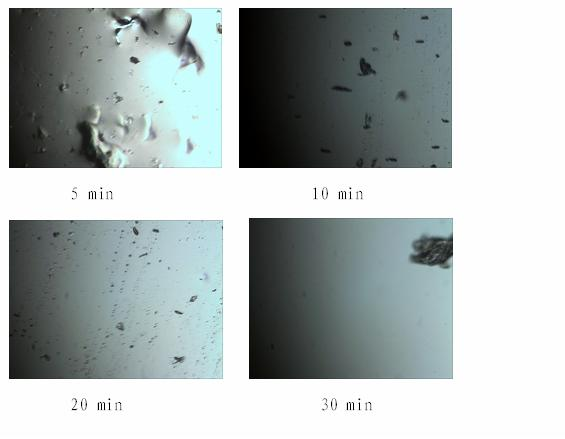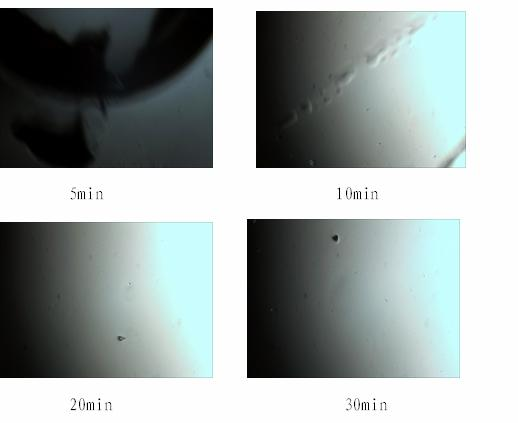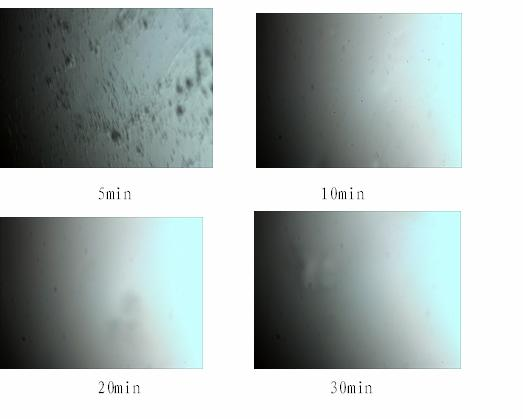Preparation method of organic silicon rubber for encapsulating LED being convenient for vacuum defoamation
A silicone rubber, LED packaging technology, used in chemical instruments and methods, adhesives, electrical components, etc., can solve the problem of low surface tension of polysiloxane, and achieve improved light transmittance, high light transmittance, and reduced surface The effect of tension
- Summary
- Abstract
- Description
- Claims
- Application Information
AI Technical Summary
Benefits of technology
Problems solved by technology
Method used
Image
Examples
Embodiment 1
[0047] 1) in N 2 Add to a 250mL dry three-necked bottle under protection polymerization Monomer D n Me,Ph (109.75g, 0.2022mol), D 4 Me,Vi (4.3g, 0.035mol), D 4 (10.035g, 0.0339mol). Remove the water in the monomer at 35℃~45℃ / -0.096MPa, then add the end-capping agent 1,1,3,3-tetramethyl-1,3-divinyl disiloxane (0.93 g, 0.005mol), catalyst tetramethylammonium hydroxide silicon alkoxide 2.48g, in N 2 Under protection, polymerize at 100°C for 5h, then decompose the catalyst at 150°C for 3-4h until the tail gas is neutral. Reduce the pressure to -0.096MPa, and gradually raise the temperature to 205°C to remove low-molecular compounds. Stop heating when there is no fraction within 5 minutes, and cool to room temperature. The obtained colorless and transparent product is the vinyl base polymer of LED packaging silicone rubber. The refractive index n was measured by a Bay refractometer D 25 =1.5350, the number average molecular weight measured by gel chromatography (GPC, usi...
Embodiment 2
[0051] 1) in N 2 Add monomer D to a 250mL dry three-neck flask under protection n Me,Ph (109.75g, 0.2022mol), D 4 Me,Vi (4.3g, 0.035mol), D 4 (9.305g, 0.0314mol), D 3 Me,F (1.1573g, 0.00247mol). Remove the water in the monomer at 35℃~45℃ / -0.096MPa, then add the end-capping agent 1,1,3,3-tetramethyl-1,3-divinyl disiloxane (0.93 g, 0.005mol), 6.23g rare earth solid superacid, in N 2 Under protection, polymerize at 100°C for 5h, and then filter to remove the catalyst. Reduce the pressure to -0.096MPa, and gradually raise the temperature to 205°C to remove low-molecular compounds. Stop heating when there is no fraction within 5 minutes, and cool to room temperature to obtain a colorless and transparent product, which is the vinyl base polymer of silicone rubber for LED packaging. The refractive index n was measured with an Abbe refractometer D 25 =1.5315, the number average molecular weight measured by GPC is 0.65×10 4 , the molecular weight distribution width (MWD) is...
Embodiment 3
[0055] 1) in N 2 Add monomer D to a 250mL dry three-neck flask under protection n Me,Ph (109.75g, 0.2022mol), D 4 Me,Vi (1.075g, 0.035mol), D 4 (7.842g, 0.02649mol), D 3 Me,F (3.4719 g, 0.00741 mol). Remove the water in the monomer at 35℃~45℃ / -0.096MPa, then add the end-capping agent 1,1,3,3-tetramethyl-1,3-divinyl disiloxane (0.93 g, 0.005mol), 6.23g strongly acidic cation exchange resin, in N 2 Under protection, polymerize at 100°C for 5h, and then filter to remove the catalyst. Reduce the pressure to -0.096MPa, and gradually raise the temperature to 205°C to remove low-molecular compounds. Stop heating when there is no fraction within 5 minutes, and cool to room temperature to obtain a colorless and transparent product, which is the vinyl base polymer of silicone rubber for LED packaging. The refractive index n was measured with an Abbe refractometer D 25 =1.5305, the number average molecular weight measured by GPC is 0.40×10 4 , the molecular weight distributio...
PUM
 Login to View More
Login to View More Abstract
Description
Claims
Application Information
 Login to View More
Login to View More - R&D
- Intellectual Property
- Life Sciences
- Materials
- Tech Scout
- Unparalleled Data Quality
- Higher Quality Content
- 60% Fewer Hallucinations
Browse by: Latest US Patents, China's latest patents, Technical Efficacy Thesaurus, Application Domain, Technology Topic, Popular Technical Reports.
© 2025 PatSnap. All rights reserved.Legal|Privacy policy|Modern Slavery Act Transparency Statement|Sitemap|About US| Contact US: help@patsnap.com



